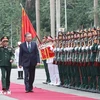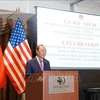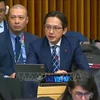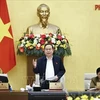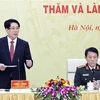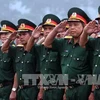Vietnam has established and exercised its sovereignty over Hoang Sa (Paracel) and Truong Sa (Spratly) archipelagos in a peaceful and continuous manner in line with international law at least since the 17 th century.
The fact was proved by legal and historical evidence which were presented to the delegates at an international seminar on Vietnam ’s sovereignty over Hoang Sa and Truong Sa archipelagos held in central Quang Ngai province.
The two-day seminar, closed on April 28, brought together domestic and foreign scholars and researchers from various countries including the US , Russia , Canada , Switzerland , Australia , India , the Republic of Korea and the Philippines .
During their discussions, the delegates analysed these legal and historical evidence, agreeing that Vietnam possesses the legal documents affirming the states of Vietnam have established and exercised their sovereignty over Hoang Sa and Truong Sa archipelagos at least since the 17 th century.
In his presentation, Jonathan D. London, a professor from the City University of Hong Kong, pointed out that China has no historical and legal evidence showing its sovereignty over the two above archipelagos.
The professor added that the official historical documents and maps published in the Chinese Ming and Qing dynasties show China ’s territory ends at Hainan island.
Many scholars slammed China ’s irrational claim over a nine-dash ‘cow-tongue’ line in the East Sea , saying the line is completely illegal as it has not yet been recognised by any international laws.
They also criticised China ’s establishment of the so-called Sansha city as violating Vietnam ’s sovereignty over Hoang Sa and Truong Sa archipelagos.
China ’s use of force to occupy Hoang Sa archipelago in 1974 and several shoals on Truong Sa archipelago in 1988 were an absolute violation of international law, they stressed.
On April 28, the delegates visited Ly Son island district and attended “Le khao le the linh Hoang Sa”, the annual Feast and Commemoration Festival for Hoang Sa Soldiers.
The traditional ceremony, taking place in An Vinh communal temple, commemorated Hoang Sa Flotilla sailors who laid down their lives for national island sovereignty.
“Le khao le the linh Hoang Sa” was recognised as part of the national intangible heritage and the An Vinh communal temple, as a national historical site.
According to Vietnam ’s feudal state history, the Hoang Sa Flotilla was set up when the Nguyen Lords began their reign in the south of the country.
Thousands of sailors overcame roaring waves and storms to survey sea routes, plant milestones and erect steles affirming national territory in Hoang Sa and Truong Sa archipelagos, and mine marine resources ordered by Nguyen Lords. Their missions were full of dangers, and many of them never returned to land.
To pay tribute to the men enlisted in the flotilla, “Le khao le the linh Hoang Sa” has been observed through hundreds of years by families in Ly Son islands and many coastal areas in Quang Ngai.-VNA
The fact was proved by legal and historical evidence which were presented to the delegates at an international seminar on Vietnam ’s sovereignty over Hoang Sa and Truong Sa archipelagos held in central Quang Ngai province.
The two-day seminar, closed on April 28, brought together domestic and foreign scholars and researchers from various countries including the US , Russia , Canada , Switzerland , Australia , India , the Republic of Korea and the Philippines .
During their discussions, the delegates analysed these legal and historical evidence, agreeing that Vietnam possesses the legal documents affirming the states of Vietnam have established and exercised their sovereignty over Hoang Sa and Truong Sa archipelagos at least since the 17 th century.
In his presentation, Jonathan D. London, a professor from the City University of Hong Kong, pointed out that China has no historical and legal evidence showing its sovereignty over the two above archipelagos.
The professor added that the official historical documents and maps published in the Chinese Ming and Qing dynasties show China ’s territory ends at Hainan island.
Many scholars slammed China ’s irrational claim over a nine-dash ‘cow-tongue’ line in the East Sea , saying the line is completely illegal as it has not yet been recognised by any international laws.
They also criticised China ’s establishment of the so-called Sansha city as violating Vietnam ’s sovereignty over Hoang Sa and Truong Sa archipelagos.
China ’s use of force to occupy Hoang Sa archipelago in 1974 and several shoals on Truong Sa archipelago in 1988 were an absolute violation of international law, they stressed.
On April 28, the delegates visited Ly Son island district and attended “Le khao le the linh Hoang Sa”, the annual Feast and Commemoration Festival for Hoang Sa Soldiers.
The traditional ceremony, taking place in An Vinh communal temple, commemorated Hoang Sa Flotilla sailors who laid down their lives for national island sovereignty.
“Le khao le the linh Hoang Sa” was recognised as part of the national intangible heritage and the An Vinh communal temple, as a national historical site.
According to Vietnam ’s feudal state history, the Hoang Sa Flotilla was set up when the Nguyen Lords began their reign in the south of the country.
Thousands of sailors overcame roaring waves and storms to survey sea routes, plant milestones and erect steles affirming national territory in Hoang Sa and Truong Sa archipelagos, and mine marine resources ordered by Nguyen Lords. Their missions were full of dangers, and many of them never returned to land.
To pay tribute to the men enlisted in the flotilla, “Le khao le the linh Hoang Sa” has been observed through hundreds of years by families in Ly Son islands and many coastal areas in Quang Ngai.-VNA
